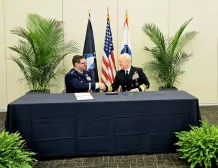‘Denial of service’ among industry concerns for proposed Space Force civil reserve fleet

NATIONAL HARBOR, Md. — After multiple engagements with industry, the Space Force is addressing top concerns from commercial firms regarding Pentagon plans to stand up a commercial space reserve fleet — including alternatives to “denial of service” clauses and options for financial protection.
The Space Force intends to have companies under contract for its Commercial Augmentation Space Reserve (CASR) by 2025 or earlier, Col. Richard Kniseley, director of the Commercial Space Office (COMSO), told reporters this week at AFA’s Air, Space and Cyber conference. The program is part of the Defense Department’s plans to leverage the commercial space industry for select military operations, as outlined in the Space Force’s Commercial Space Policy released in April.
Once finalized, the framework would allow the DOD to contract commercial space services during peacetime that would specifically be used during times of crisis or conflict — much like the Air Force’s Civil Reserve Air Fleet.
As it irons out details for the CASR contract, COMSO has engaged with dozens of firms during three separate industry days to discuss any concerns with the service’s draft framework, Kniseley said. The office is now reviewing responses to its request for information published in August, which included a draft readiness plan, incentive plans and contract clauses.
“This is a partnership, and it’s a voluntary partnership, so it’s important for us to get that industry feedback to make sure that this is a construct that they want to be a part of,” he said.
One key issue brought up by commercial companies has been the Space Force’s proposed “H clauses,” Kniseley noted. Two levels of industry support are outlined in the RFI — one intended for “day-to-day” and “surge” operations in the event of regional conflict or significant crisis, and a second known as “full CASR execution” that would be triggered by an order from the secretary of defense during a larger conflict.
If it’s decided that full CASR execution is needed, the RFI states the Defense Department would impose “direct denial of service to vendor customers or denial of service over designated geographic areas” — meaning industry would be prohibited from selling or providing services to other customers during that time. Three alternative H clauses are also included in the RFI.
“Some of the feedback from industry is that it just really puts them in a bad situation with their current contracts,” Kniseley said. “I would even say from a government standpoint, we kind of come in overbearing, if you will, and I don’t think it would be part of a partnership.”
One option industry has proposed is to have the Space Force consider linking the direction for denial of service to established sanctions lists, which would restrict sanctioned entities from accessing commercial products and services that are under CASR contracts, Kniseley later told DefenseScoop in an email.
The approach would simplify full CASR implementation by aligning with existing laws, mitigate risk of interference with other commercial business and streamline operational decisions in the event of conflict, he added.
“The primary distinction between this approach and the contract clauses options outlined in the RFI is its targeted, easily implemented and statutorily anchored nature,” Kniseley wrote. “Unlike draft contract clauses that sought contractor agreement to give exclusive access and 100 percent denial of other customers during crises, leveraging sanctions lists keeps denial of service during full CASR execution within already established legal boundaries, thus reducing the full CASR execution hurdles for companies and/or the government.”
Kniseley emphasized that the sanctions list option is not finalized, but added that the government continues to assess the approach for inclusion in the final framework.
Another point of interest for commercial industry has been financial protections in the event a company’s on-orbit systems are damaged or destroyed during war time, Kniseley said at the roundtable. Financial protection tools — including “commercial war-risk” insurance and indemnification — is one of nine incentives for industry to join CASR outlined in the RFI.
While working closely with the assistant secretary of defense for space policy on financial protections, Kniseley said COMSO has also met with legal professionals and private insurance companies to understand the service’s options for providing war-backed insurance. He noted that industry has routinely brought up options for indemnification, which would have the Defense Department compensate companies for damages or losses to their systems.
“I think legally, it doesn’t really fit the mold there. But I think the recognition is that we will easily continue to work with [the Office of the Secretary of Defense] on what that looks like,” Kniseley said.
Sustainable funding, access to wargaming exercises and threat-sharing mechanisms have been additional concerns from industry. Kniseley said COMSO is strengthening its partnership with the Space Force’s Joint Commercial Operations Center, the Commercial Integration Cell and the Space Information and Security Access to improve how it shares threats with future CASR members.
Kniseley noted that each CASR contract will likely not be the exact same, and COMSO will modify them based on specific mission areas and possibly through negotiations with each company. The office is about to kick-off mission area analysis for specific contracts.
“We’re looking at commercial SATCOM as it supports the Indo-Pacific region, working with the space component out there, as well as [the Space Warfighting Analysis Center], that will lay the foundation of how much we actually need to put on contract, and kind of extrapolate what a potential war would look like,” Kniseley said.






